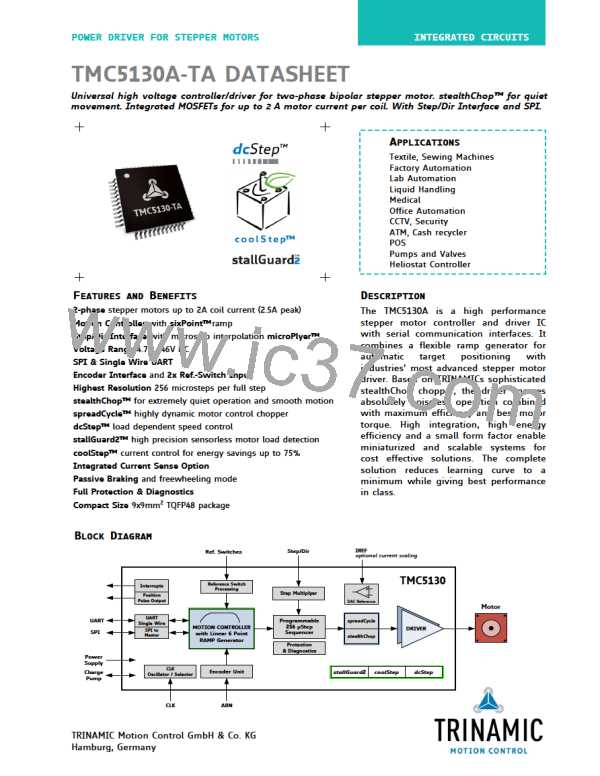TMC5130A DATASHEET (Rev. 1.14 / 2017-MAY-15)
51
7 stealthChop™
stealthChop is an extremely quiet mode of operation for stepper motors. It is based on a
voltage mode PWM. In case of standstill and at low velocities, the motor is absolutely
noiseless. Thus, stealthChop operated stepper motor applications are very suitable for
indoor or home use. The motor operates absolutely free of vibration at low velocities.
With stealthChop, the motor current is applied by driving a certain effective voltage into
the coil, using a voltage mode PWM. There are no more configurations required except for the PWM
voltage regulator response to a change of motor current. Two algorithms are provided, a manual and
an automatic mode.
Figure 7.1 Motor coil sine wave current with stealthChop (measured with current probe)
7.1 Two Modes for Current Regulation
In order to match the motor current to a certain level, the stealthChop PWM voltage must be scaled
depending on the actual motor velocity. Several additional factors influence the required voltage level
to drive the motor at the target current: The motor resistance, its back EMF (i.e. directly proportional
to its velocity) as well as actual level of the supply voltage. For the ease of use, two modes of PWM
regulation are provided: An automatic mode using current feedback (pwm_autoscale = 1) and a feed
forward velocity controlled mode (pwm_autoscale = 0). The feed forward velocity controlled mode will
not react to a change of the supply voltage or to events like a motor stall, but it provides very stable
amplitude. It does not use nor require any means of current measurement. This is perfect when
motor type and supply voltage are well known. Since this mode does not measure the actual current,
it will not respond to modification of the current setting, like stand still current reduction. Therefore
we recommend the automatic mode, unless current regulation is not satisfying in the given operating
conditions.
The PWM frequency can be chosen in a range in four steps in order to adapt the frequency divider to
the frequency of the clock source. A setting in the range of 30-50kHz is good for many applications. It
balances low current ripple and good higher velocity performance vs. dynamic power dissipation.
CHOICE OF PWM FREQUENCY FOR STEALTHCHOP
Clock frequency
fCLK
18MHz
PWM_FREQ=%00
fPWM=2/1024 fCLK
35.2kHz
PWM_FREQ=%01
fPWM=2/683 fCLK
52.7kHz
PWM_FREQ=%10
fPWM=2/512 fCLK
70.3kHz
PWM_FREQ=%11
fPWM=2/410 fCLK
87.8kHz
16MHz
31.3kHz
46.9kHz
62.5kHz
78.0kHz
(internal)
26kHz
38kHz
52kHz
64kHz
12MHz
23.4kHz
35.1kHz
46.9kHz
58.5kHz
10MHz
19.5kHz
29.3kHz
39.1kHz
48.8kHz
8MHz
15.6kHz
23.4kHz
31.2kHz
39.0kHz
Table 7.1 Choice of PWM frequency – green: recommended
www.trinamic.com

 TRINAMIC [ TRINAMIC MOTION CONTROL GMBH & CO. KG. ]
TRINAMIC [ TRINAMIC MOTION CONTROL GMBH & CO. KG. ]